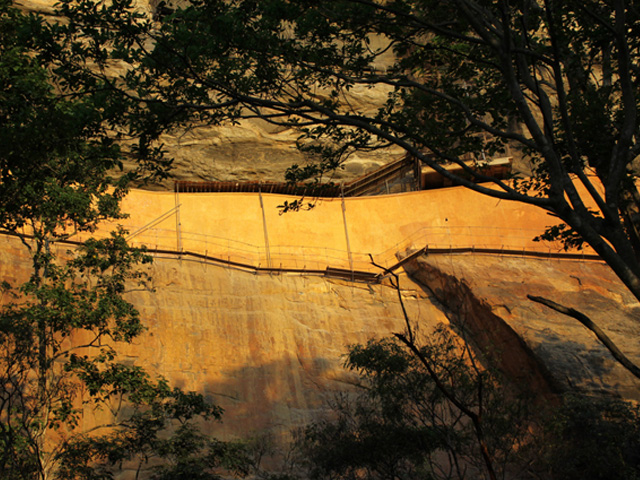Highlights of Sigiriya
The Fortress On The Rock
Sigiriya is an archelological site in North Central Sri Lanka. It contains the ruins of an ancient palace complex, built during the regin of King Kasyapa (477AD – 495 AD). It is one of the 7 world heritage sites in Sri Lanka and is one of it’s most popular tourist destinations.
The Sigiriya site consistes of a 180m tall granite rock, whose sides are so steep that at some points the top overhangs the base. At the top of the site there is a palace complex. The ruines of various chambers, stairways and pools can be seen at the top. There is a stone stairway leading from the base to the top of the mountain. About half way to the top, there is a pair giant pair of lions paws which is infact the ruind of a huge head of a lion whose open mouth served as the entrance to the royal palace. Surrounding the palace complex are the ruins of a garden complex consisting of two moats, various pools.
Sigiriya Frescos
John Still in 1907 had observed that; “The whole face of the hill appears to have been a gigantic picture gallery… the largest picture in the world perhaps”.The most renowned is the Sigiriya Rock Paintings or Frescoes of Sigiri Damsels locally called as ‘ Sigiri Apsaras’ painted on a Western Rock face cavity about 100 meters high from the rock base .There now remains around 21 paintings of Sigiriya Damsels but there had been around five hundred paintings during King Kassapa’s’ time along several other places of the same Western Rock face.
The Mirror Wall
Originally this wall was so highly polished that the king could see himself whilst he walked alongside it. Made of brick masonry wall and covered in highly polished white plaster, the wall is now partially covered with verses scribbled by visitors to the rock. The mirror wall has verses dating from as early as the 8th century. People of all types wrote on the wall, on varying subjects such as love, irony, and experiences of all sorts. Further writing on the mirror wall now has been banned for the protection of old writings of the wall.
The Water Gardens
The water gardens are built symmetrically on an east-west axis. They are connected with the outer moat on the west and the large artificial lake to the south of the Sigiriya rock. All the pools are also interlinked using an underground conduit network fed by the lake, and connected to the moats. A miniature water garden is located to the west of the first water garden, consisting of several small pools and watercourses. This recently discovered smaller garden appears to have been built after the Kashyapan period, possibly between the 10th and 13th centuries.
























